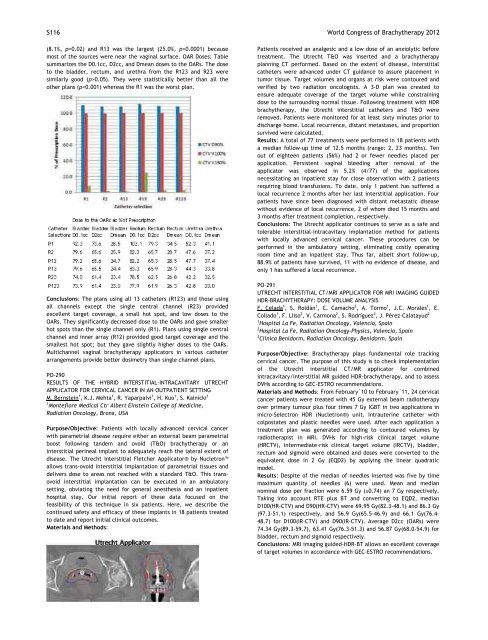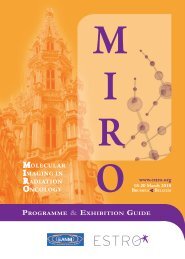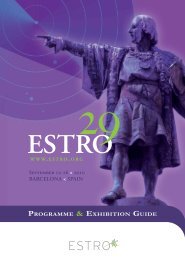World Congress of Brachytherapy 10-12 May, 2012 - Estro-events.org
World Congress of Brachytherapy 10-12 May, 2012 - Estro-events.org
World Congress of Brachytherapy 10-12 May, 2012 - Estro-events.org
Create successful ePaper yourself
Turn your PDF publications into a flip-book with our unique Google optimized e-Paper software.
S116 <strong>World</strong> <strong>Congress</strong> <strong>of</strong> <strong>Brachytherapy</strong> 20<strong>12</strong><br />
(8.1%, p=0.02) and R13 was the largest (25.0%, p0.05). They were statistically better than all the<br />
other plans (p<strong>10</strong> on their pre treatment PET scan. 60% <strong>of</strong><br />
distant metastases occurred in patients with a nodal SUV >4 on pre<br />
treatment PET scan. In patients with 3 month post treatment PET scan<br />
(54%), 75% <strong>of</strong> patients with a SUV >4 suffered a local recurrence. 30<br />
month estimates for local control, disease free survival, metastasis<br />
free survival, and overall survival using KM curves are 80%, 30%, 42%<br />
and 65% respectively.<br />
: MRI based interstitial brachytherapy for locally advanced<br />
cancers <strong>of</strong> the cervix and vagina results in a high rate <strong>of</strong> local control.<br />
Additionally, a HRCTV D90 > 95%, an initial staging PETCT SUV max<br />
><strong>10</strong> and a 3 month posttreatment SUV <strong>of</strong> >4 correlate well with local<br />
control. A pretreatment PETCT nodal SUV >4 may be a better<br />
predictor for distant metastasis than an SUV ><strong>10</strong> <strong>of</strong> the primary.<br />
Though longer followup is required, MRI based planning appears to<br />
provide initial excellent local control and distant metastasis free<br />
survival.<br />
PO293<br />
OUTCOMES FOR RECURRENT ENDOMETRIAL CANCER WITH HDR<br />
INTERSTITIAL BRACHYTHERAPY UTILIZING MRI BASED PLANNING<br />
M.C. Biagioli 1 , J.M. Freilich 1 , A. Cruz 1 , A.S. Saini 1 , D.C. Hunt 1 , J. Shi 1 ,<br />
D.C. Fernandez 1<br />
1<br />
H. Lee M<strong>of</strong>fitt Cancer Center, Radiation Oncology, Tampa Florida,<br />
USA<br />
: Recent data has emerged demonstrating<br />
significant advantages to MRI based planning over CT based planning<br />
in the brachytherapy treatment <strong>of</strong> cancer <strong>of</strong> the cervix. The purpose<br />
<strong>of</strong> this study is to evaluate our experience utilizing MRI based<br />
brachytherapy treatment planning for patients with recurrent<br />
endometrial cancers who underwent an interstitial implant as part <strong>of</strong><br />
there treatment.<br />
: A retrospective review was conducted <strong>of</strong> all<br />
endometrial cancer recurrences treated at M<strong>of</strong>fitt Cancer Center from<br />
20092011 where 1.5 T contrast enhanced MRI based high dose rate<br />
(HDR) interstitial brachytherapy was part <strong>of</strong> their treatment plan. <strong>12</strong><br />
patients were identified and local recurrence, disease free survival,<br />
metastasis free survival, and overall survival were analyzed in the<br />
whole group and based on prognostic features and treatment plans.<br />
: Mean followup was <strong>10</strong> months (range 216). 92% <strong>of</strong> patients<br />
had recurrent disease, 17% received chemotherapy and 83% received<br />
external beam radiation therapy with a median dose (range) <strong>of</strong> 4920<br />
cGy (43205500). Median (range) brachytherapy total dose and dose<br />
per fraction was 2500 cGy (22003500) and 500 cGy (450600),<br />
respectively. Local recurrence rate was 16.7% with estimated mean<br />
time to local recurrence <strong>of</strong> 13 months. In patients with the CTV D90<br />
greater than 95%, local recurrence was <strong>10</strong>% versus 50% if less than or<br />
equal to 95%. Disease free survival was 67% with estimated mean time<br />
to event <strong>of</strong> 9 months. Metastasis free survival was 80% in patients<br />
without metastatic disease on presentation with estimated mean time<br />
to metastasis <strong>of</strong> 7 months. Overall survival was 67% with estimated<br />
mean time to death <strong>of</strong> 9 months. 15 month estimates for local<br />
control, disease free survival, metastasis free survival, and overall<br />
survival using KM curves are 70%, 62%, 62% and 62%, respectively.<br />
: MRI guided interstitial brachytherapy results in a high<br />
level <strong>of</strong> local control in patients with pelvic recurrences after primary<br />
treatment for endometrial cancer. Though initial followup is short<br />
this local control appears to result in a high level <strong>of</strong> DFS. Of the 2<br />
local failures there was no pretreatment PET information available.<br />
Additionally, patient number was too small to determine the utility <strong>of</strong><br />
3 month posttreatment PET as a predictor for local or distant<br />
failures.<br />
PO294<br />
BRACHYTHERAPY<br />
TURKEY<br />
EXPERIENCE IN GYNAECOLOGICAL TUMORS IN<br />
I. Aslay 1 , B.W.G. <strong>Brachytherapy</strong> Working Group 2<br />
1<br />
Istanbul University Oncology Institute, Radiation Oncology, Istanbul,<br />
Turkey<br />
2<br />
Oncology Institutes, Radiation Oncology, Istanbul, Turkey<br />
: This study is conducted to evaluate the<br />
brachytherapy experience in gynaecological tumors in Turkey.<br />
: Gynaecological brachytherapy data <strong>of</strong> 11<br />
medical faculty, one government hospital and two private hospitals<br />
between 19702011 was collected. Ovarian cancer was not included.<br />
Median brachytherapy (BrT) experience <strong>of</strong> the centers was <strong>12</strong> (141)<br />
years. The total number <strong>of</strong> the patients (pts) was 297<strong>12</strong>4 and 7% <strong>of</strong><br />
them was gynaecological tumor (except ovary). The ratio <strong>of</strong> the<br />
tumors was %49 in cervix carcinoma (CC), %46 in endometrium<br />
carcinoma (EC), %1 in vagina carcinoma (VaC), %3 in vulvar carcinoma<br />
(VuC).<br />
: For curative treatment <strong>of</strong> CC concomitant chemotherapy<br />
(CCh) 40mg/m2 weekly was standard procedure in all centers. In<br />
postoperative CC , Cch was given if poor prognostic factors present<br />
such as positive margin, positive lymph node, bulky tumor, positive<br />
parametrium. Adjuvant Ch to radiotherapy was not given in any<br />
center. The incidence <strong>of</strong> the pts treated with curative intent in EC<br />
and VuC was low. Ch was given in EC pts if advanced stage or poor<br />
hystology was present. In VuC, Ch was given due to comorbidities <strong>of</strong><br />
the pts and also BrT was not applicated as a treatment component<br />
except in salvage therapy. VaC was treated mostly with the same<br />
protocol <strong>of</strong> CC. Salvage treatment was done with external<br />
radiotherapy (ERT) and/or BrT in two centers, with only ERT in 3<br />
centers and with cyberknife in one center. Eight centers have no<br />
salvage treatment experience. ERT technigues were 3D and IMRT in<br />
three centers, 3D in 7 centers, 2D and 3D in 4 centers. Except two<br />
centers with two and one center with 5 BrT machines all the others<br />
have one HDR treatment unit. BrT technigue was 3D in 6 , 2D in 8<br />
centers. Two centers also have LDR experience. ERT, BrT and total<br />
treatment doses are listed in table 1.









